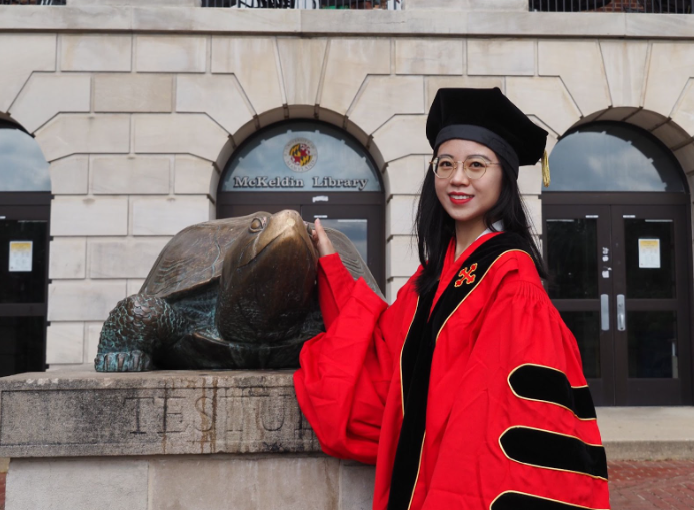
The Data-Driven EnviroLab welcomes Kaihui Song, our new postdoctoral research associate. Kaihui obtained her Ph.D. in Geographical Sciences at the University of Maryland. She is a sustainability enthusiast and a well-trained professional with over nine years of experience in sustainable development and the circular economy. Here are some of her thoughts on her experiences with global emission accounting and researching subnational climate actions.
Tell us about your doctoral research. What interested you about this topic?
KS: My doctoral research focused on climate mitigation actions from state-level actors and households in the U.S. I became enthusiastic about this topic when I started graduate school, realizing the urgency of curbing climate change and the need for exploring new climate policies and effective climate governance. Emerging collective climate actions have great potential to limit global warming to the 1.5 °C goal. Still, they require a consistent and credible quantification of their greenhouse gas emissions to track and assess their performance. A crucial part of emissions that requires more attention is emissions embodied in supply chains, where emissions are generated in one state to meet the demand for products from another. I wanted to better understand how the embodied emissions affect the effectiveness of current climate policies and their relevance to other Sustainable Development Goals.
You’ve done research examining carbon flows between U.S. states. Why is this a critical issue for climate change policy?
KS: When considering climate mitigation responsibilities, there are different emission allocation principles. Current climate policies are mainly supported by territorial greenhouse emission accounting, which is measuring emissions generated within an administrative boundary. However, recent studies suggest that emissions embodied in supply chains add increasing complexities to attributing climate responsibility due to the difficulty in tracing embodied emissions and the lack of standardized regulations. From the research perspective, this difficulty increases at higher spatial resolutions. For example, studies of China at the provincial level have found that embodied GHG emissions account for approximately half of the total consumption-based emissions (where emissions are attributed to where the products are consumed), and this proportion can increase to over 70% at the city level11/mfn], 12. Analysis incorporating virtual carbon flows (or embodied emissions) captures another aspect of climate responsibility in addition to direct emissions generated within a geographical boundary, which better informs subnational climate policies, ranging from market-based instruments to regulatory policies that target individual carbon-intensive behaviors.
You use a range of methods in your research, from life-cycle analysis to machine learning, etc. How did you choose these methods, and what are some of their limitations?
KS: With an environmental science background, I was trained to employ systematic approaches to address environmental issues. I strive to find the best approach to answer my research questions, such as, how would embodied emissions affect the effectiveness of current state-level climate mitigation policies? What are the challenges and opportunities for households to reduce their carbon footprints? Scholars from different disciplines offer different perspectives with various approaches. I try to take the strengths from multiple disciplines to improve our model performance and inform policy making. For example, a macroeconomic model requires that emission accounting from the whole supply chain accounts for emissions driven by a state’s consumption but generated outside their jurisdictions. As for machine learning, these approaches are widely used in commercial settings but can also help catalyze collective climate mitigation actions. In my research, I combine macroeconomic models, econometric methods, and machine learning approaches with the hope of overcoming limitations in any one field.
What excites you the most about your work at the Data-Driven EnviroLab?
KS: Data-Driven EnviroLab has done extensive research on subnational climate mitigations through data-driven approaches. I am very excited to join the team in pushing the boundaries of knowledge in climate mitigation from subnational and non-state climate actors. My work here will primarily be focusing on evaluating subnational actors’ climate mitigation performance, specifically their efforts in catalyzing subnational climate actions. Apart from that, I also enjoy working with DDL team members, who have diverse cultural and professional backgrounds. It’s a real pleasure and privilege to be working with policy experts, data scientists, visual designers, and interactive programmers around the world.
Tell us something that people may not know about you.
KS: I love learning about cultures and languages as well as trying out new activities. In my spare time, I love hiking, photography, and creating artwork that helps communicate environmental issues to the public.

Recent Comments